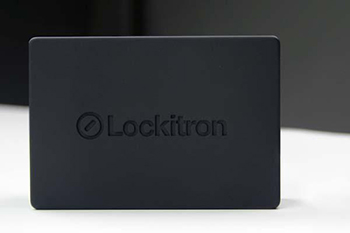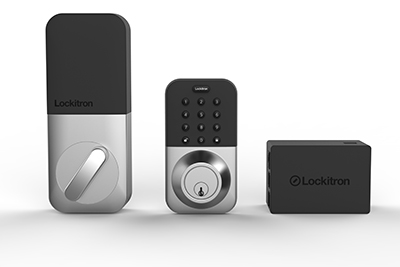Since the dawn of time, humans use locks and padlocks to protect what is most dear to them. Whether we think of pirate trunks or princesses imprisoned in the highest towers of the castle, locks and their safely stored keys represented the main safety features.In recent years technological innovations have tried to improve these “medieval” safety features, making padlocks smarter and redefining the concept of the key.
Lockitron: the Smart Lock
Lockitron is a device that certainly works towards this direction.
Basically, we are talking about a smart lock, designed and developed for revolutionizing our daily habits and our house safety. In 2012, the start-up, named Apigy (whose headquarters are in Mountain View, in California, as those of Google) launched the original version of this smart lock.
Through its crowd-funding website, the company collected pre-orders for up to 1.5 million dollars.
Kickstarter, refused to accept the project, for reasons that were never fully clarified, forcing Apigy’s founders to invent a new crowd-funding platform (currently known as Selfstarter).
The way Lockitron works is always the same. It is based on the key-lock concept, however, what has been revolutionized is the way the key and the padlocks are designed.
First of all, the padlock is equipped with a Bluetooth 4.0 Module (low energy) that allows to automatically open the door on which it is installed, through the Lockitron app, which can be directly downloaded on your smartphone or tablet.
The padlock is not equipped with a Wifi module, therefore it is not possible to open a door remotely (many people do not have this type of requirement).
However, there are thousands of different situations where the user life can be greatly simplified through a remote control.
For example, if you are not at home but you want to allow a family member or a friend to enter. You are on holiday and you want to let the housekeeper in, or even if you are the owner of several apartments and you wish to rent them to strangers for a limited period of time.
Additional module: the Bridge
For those users who have similar needs, Lockitron designed an additional module called the Bridge.
This module interacts either with the padlock via the blue tooth, as well as with the user, through an Internet connection.

Thanks to this additional module, known as the Bridge, Lockitron showed its best features. This module allows to notify the user if and when the door is opened.
Therefore, this is a very useful feature in the event of an unauthorized access or someone trespassing, if the bridge is integrated into a broader surveillance system.
Secondly, it is possible to open and close the door remotely, either manually or automatically.
All these features are easily accessible through the dedicated app, which is the key access to the entire system.
Thanks to this app, your mobile phone becomes the opening key for the padlock, but this is not all.
It should be added that the app transforms your smartphone into a veritable security hub for your house, through which it is possible to not only physically open doors, but configure and manage the access keys, their temporal validity, limited access and alerts etc.
Compatibility of the app
The app is available only for two mobile operating systems, i.e. Android and iOS, and it can be easily installed through the Play Store and AppStore.
The pairing (coupling) between Lockitron and the app is simple and immediate. It does not require any particular procedures.
To create additional and temporary keys, there are simple guided features that help the user to configure them step by step.
Moreover, it also possible to add authorized users.
This functionality seems to be very interesting in a business context.
If the additional module, the Bridge, is installed, it is also possible to manage Lockitron through its web page.
Therefore, it is possible to use it with other operating systems, such as Windows for instance.
Unfortunately, for Windows Phone users, Apigy has recently announced that they are not planning to develop a dedicated app in the near future.
Another interesting aspect concerns the integration with the different smart watches and fitness trackers available on the market.
Thanks to their SDK ads, developers were able to make Lockitron compatible with Pebble and other smartwatch models.
Therefore, it is now possible to use the smart watch as a key, or associate certain movements to the opening and closing of the door.
Hardware Installation
 The physical installation of Lockitron is not as easy as the one of its software.
The physical installation of Lockitron is not as easy as the one of its software.
Since Lockitron is not a plug and play device, it must be physically inserted where the conventional lock used to be.
Although Apigy guarantees that the installation will not take longer than 20 minutes, many users have complained about the complexity of the task, or because it was not possible to replace their traditional lock.
Therefore, please do verify that your lock is compatible before purchase.
That is why Lockitron makes available on its website a template (http://help.lockitron.com/article/49-will-lockitron-work-with-my-door) that you should print out and compare to your lock before proceeding with the purchase. Lockitron doesn’t require any electrical connection to work.
It comes with 4 AA batteries that, thanks to their low energy Bluetooth feature, guarantee a 6 months of self-sufficiency. Lockitron and Bridge can be purchased directly on the official store (https://lockitron.com/store) and, of course they can be shipped to Italy.
Regarding the price, Lockitron costs 99 dollars and is only available in Quicksikver (the Modern Gold version is coming, but not available yet).
The bundle that consists of the Lockitron and the Bridge costs 178 dollars instead and stocks are limited.
If on the one hand Lockitron is shipped within 2 weeks from receipt of your order, for the bundle you will have to wait from 8 to 10 weeks.
From the Wikipedia Lockitron page (https://en.wikipedia.org/wiki/Lockitron), it is possible to understand that even though many bundle orders have already been shipped, the company refuses to provide information about the shipment of the bundle.
Moreover, it seems that many early backers (the users who donated during the crow-funding campaign) have never received their Lockitron.
